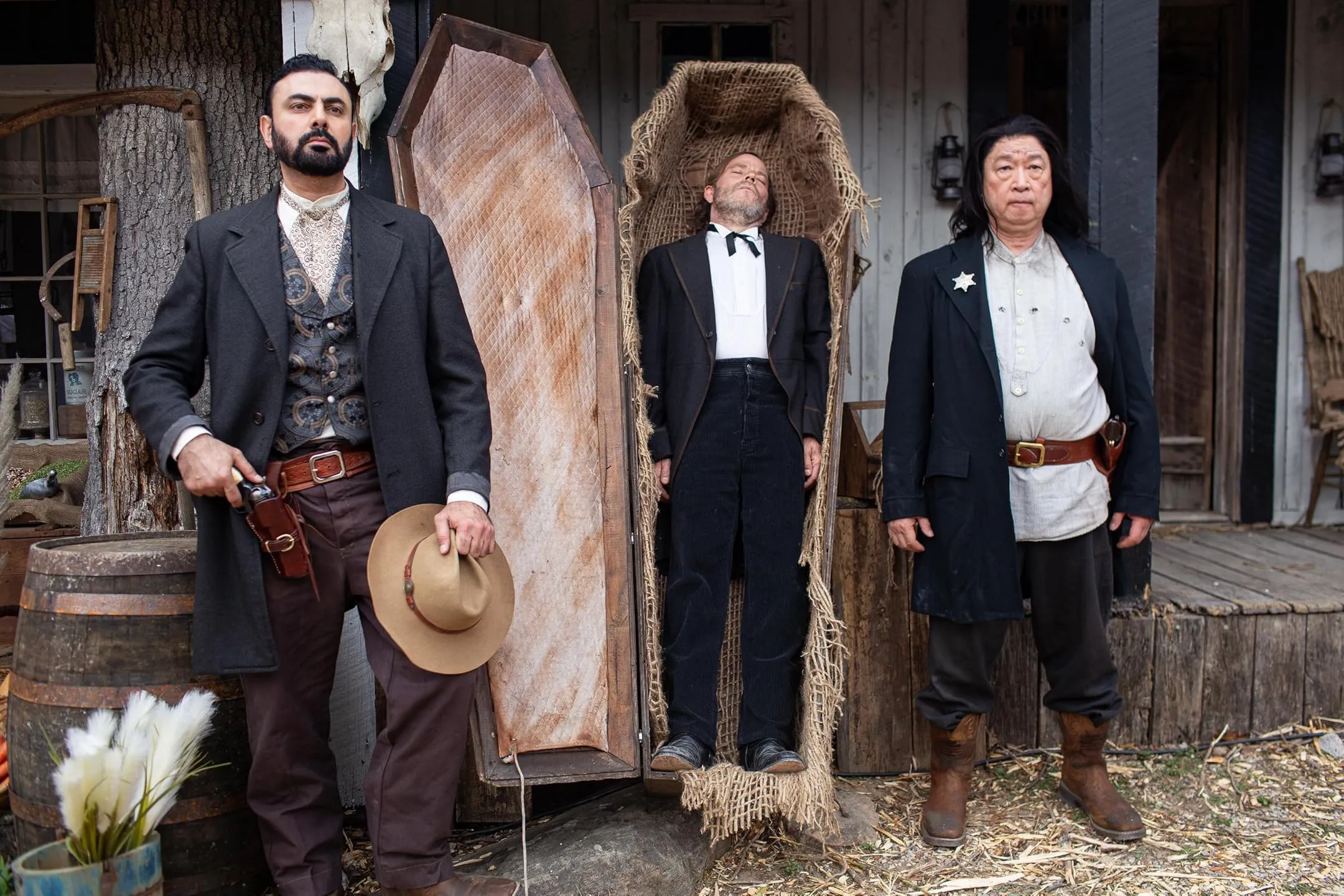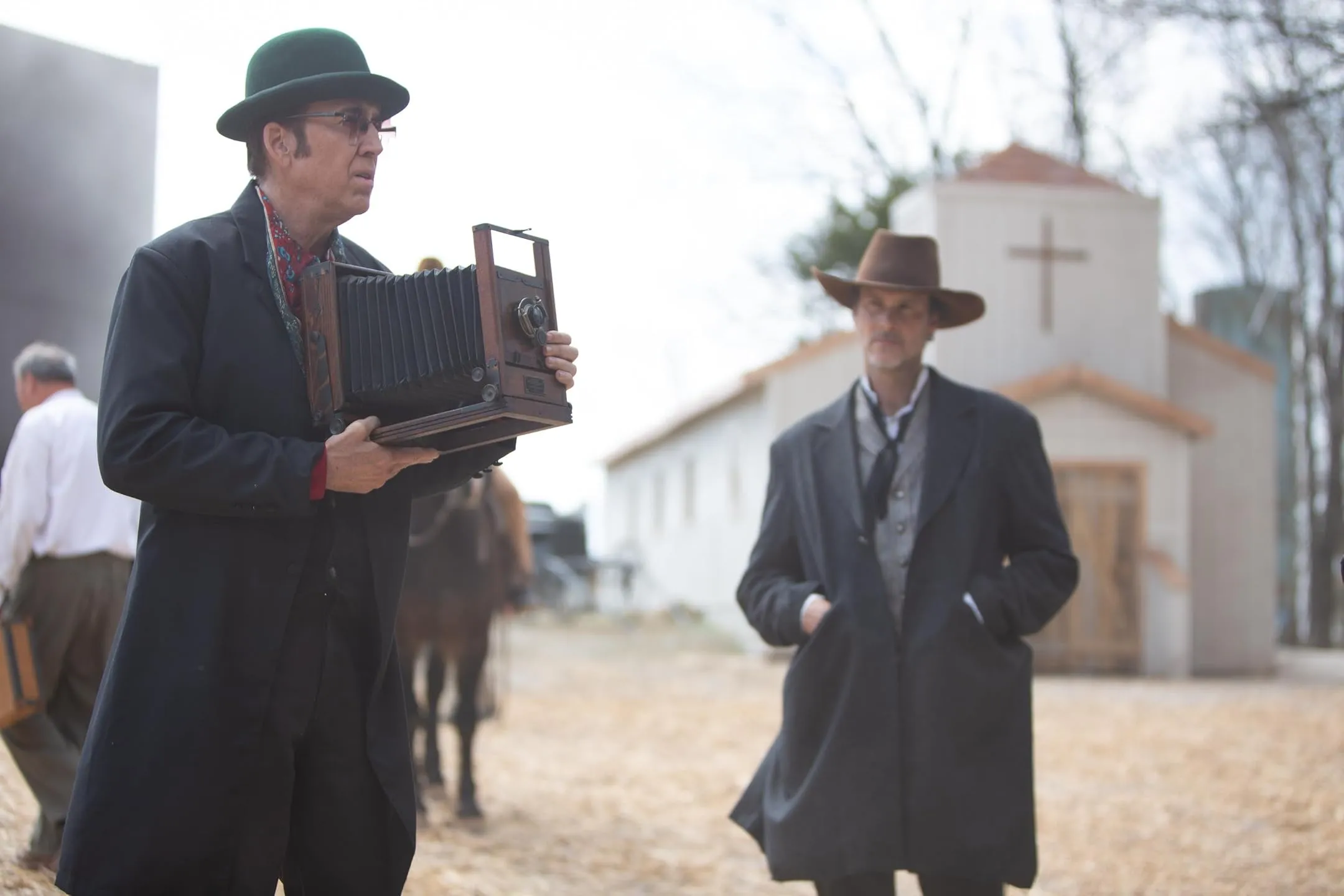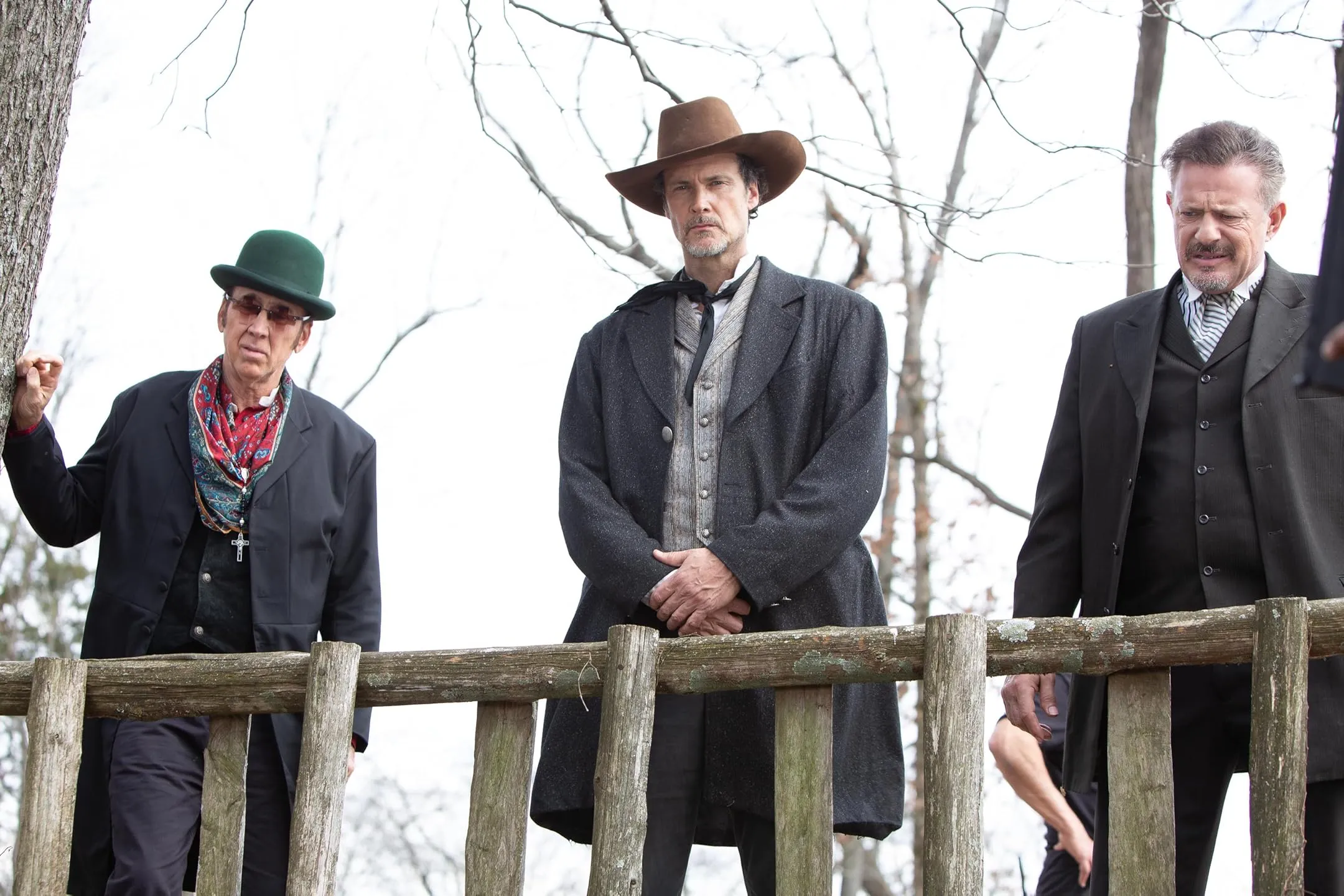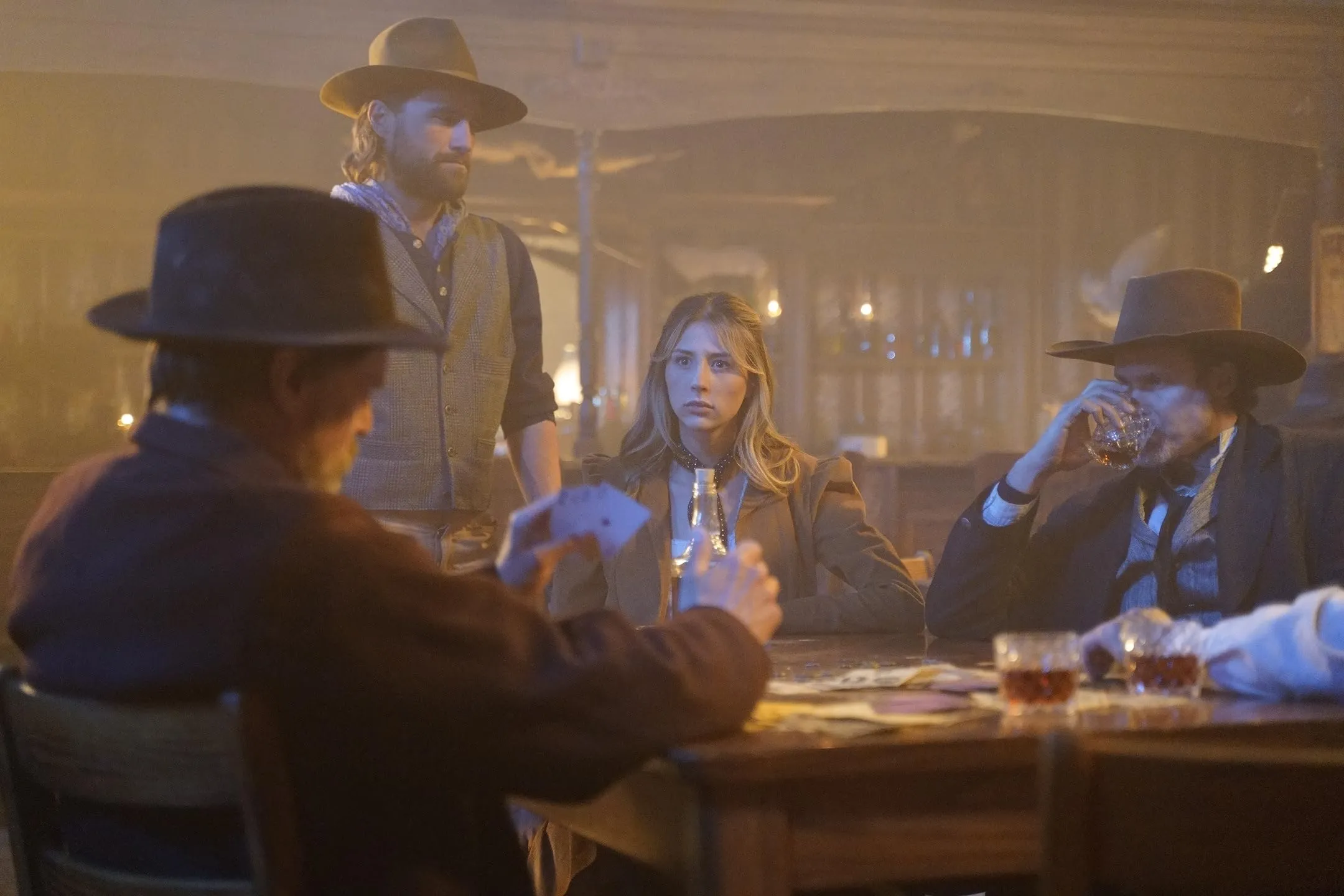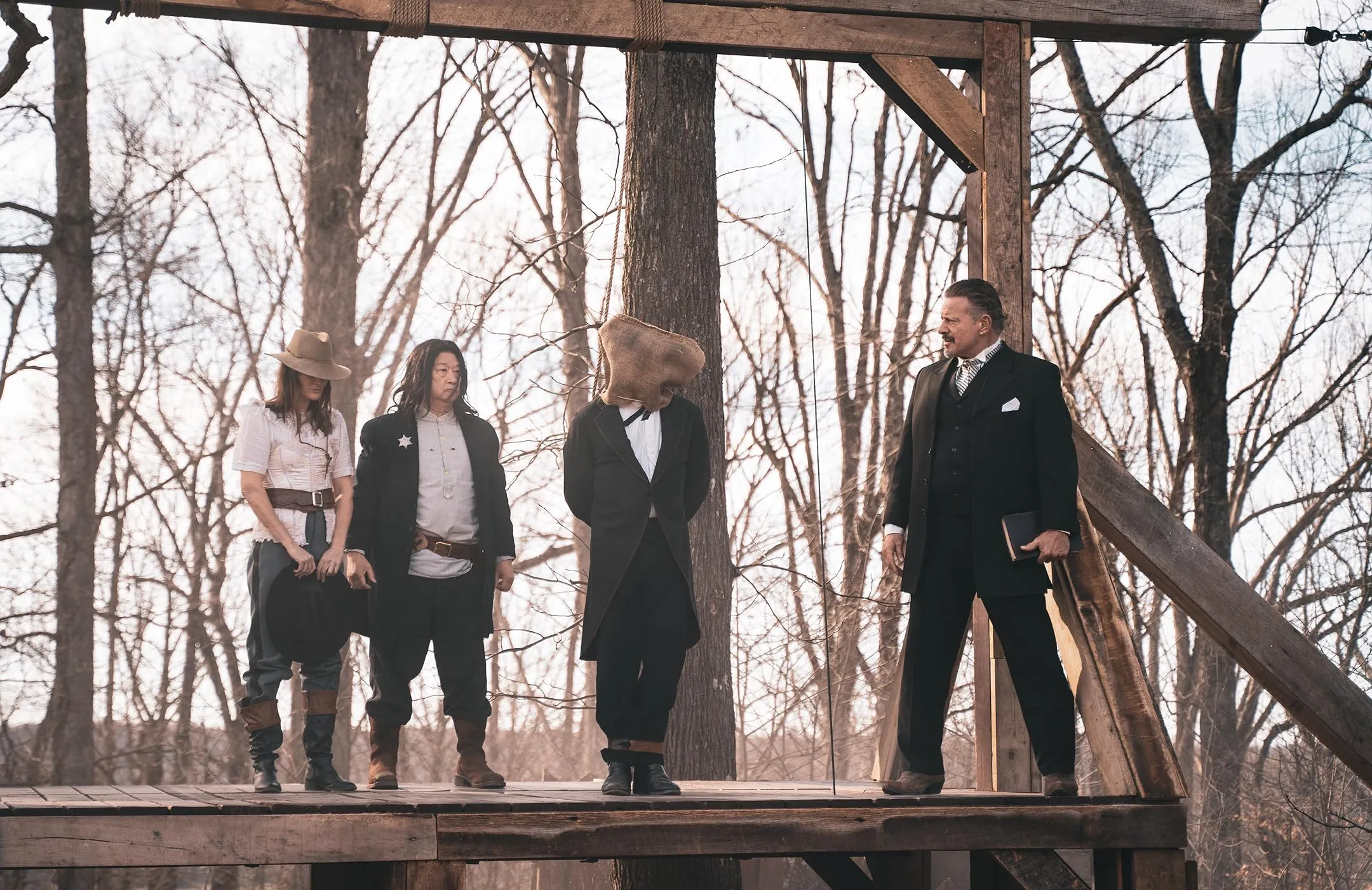Gunslingers opens with a brooding whisper of lost dreams amid a rugged frontier. This cinematic study of human frailty unfolds against a backdrop that shifts from the ceaseless clamor of early 20th-century New York to the forsaken alleys of Redemption, Kentucky—a haven where those shunned by society seek a fragile respite.
The film entices with its Western framework set in an unconventional locale, rife with a stark interplay of humor and somber violence. Its narrative unfolds like a ragged tapestry, stitched together by an outlaw in flight whose path meanders through both stark peril and unexpected humor.
The urban decay of New York gives way to the wild, uncontrolled essence of a town inhabited by renegades yearning for rebirth. It raises questions about the cost of shedding one’s past, exposing the personal toll when an individual stands at the crossroads of self-destruction and reformation.
Amid rustic landscapes and weathered stone, an eclectic congregation of marginalized souls gathers—a community united by its quest for a second chance, bound by the remnants of former sins and silent promises of change. This opening act ignites a spark in the viewer, inviting contemplation of the eternal struggle between inner torment and the yearning for salvation.
Shadows of Fate and the Uncertain Road
In the dim-lit alleys of 1903 New York City, the film opens with a crisp portrayal of chaos—a city whose relentless hum reflects the inner disquiet of Thomas Keller. Keller’s initial act of violence, a singular transgression among many, is rendered as both a spur of desperation and a herald of transformation. His sin, etched into the fabric of a sprawling metropolis, becomes the catalyst for a journey that promises both ruin and renewal.
An incident of lethal retribution binds Keller to the hidden workings of an elite few, their power echoed in the cold corridors of wealth and influence. The film follows his perilous escape, mapping a transition from the urban tempest toward a sanctuary carved out in Redemption, Kentucky. This journey, marked by the sharp contrast between the unforgiving concrete of New York and the rugged embrace of a forsaken town, questions the very nature of refuge and exile.
Within Redemption, the narrative unspools as a delicate dance of tension and tentative hope. Characters emerge in fleeting vignettes—each bearing their own scars—adding layers of ambiguity to the tapestry of rebellion and remorse. As external forces, driven by competing desires and agendas, ride into town, the fabric of the outlaw enclave is tested under a barrage of conflicting wills and moral dilemmas.
The film steadily tightens its grip, building toward a charged standoff where the line between orchestrated demise and the peril of real defiance blurs. Echoes of staged executions resonate as ephemeral warnings, while threats from beyond remind us that the past is never entirely banished. Keller’s flight and the town’s struggle to remain unyielding leave the narrative suspended in a moment of uncertainty, inviting a reflection on the ceaseless interplay between regret and the yearning to be reborn.
Echoes of the Outlaw Soul
Thomas Keller emerges as a drifting shadow amid a realm of forgotten dreams—a man caught between the relentless pull of his violent history and a muted yearning for absolution. His existence is painted in strokes of inner discord, each echo of his past carving fissures in his present. A life built upon misdeeds compels him to wander the corridors of guilt and fragile hope, his countenance marred by regret and longing for a salvation that may never fully embrace him.
A spectral figure circles his path—a devoted kin whose pursuit radiates the bitter remnants of familial strife. The chase is not measured in mere footsteps but is a slow dance of remembrance and vengeance, where each encounter speaks of old wounds and the heavy cost of legacy. Their relentless confrontation summons questions of duty and the price paid for sins passed down like a cursed inheritance.
Within the hardened walls of Redemption, the town’s inhabitants form a collage of those forsaken by society. Their lives, interlocked by collective misfortune, forge a crucible wherein identity is both shattered and remade. Among these weathered souls, a singular character stands apart: a reformed gunslinger whose unusual tone and eccentric manner infuse fleeting moments of levity into an otherwise grim ensemble. His portrayal, both stark and idiosyncratic, punctuates the narrative with hints of irony and latent despair.
The cast, each performance a brushstroke in a larger nocturne of human imperfection, captures the tension between the theatrical and the unguarded. Their interactions spill forth as raw, sometimes discordant harmonies that stir the burden of past transgressions. Subtle exchanges on dimly lit porches and in the murmuring of shared confidences reveal the splintered fragments of souls seeking refuge in the impermanent, uncertain solace found within Redemption’s clandestine embrace.
Shattered Frames and a Stylistic Mirage
Director Brian Skiba crafts his work with a restless urgency that reverberates through each scene. His methods imprint a hurried intensity upon the film, suggesting a world where every second pulses with the raw energy of revolt and despair. Skiba’s storytelling, marked by an instinct for Western imagery twisted through modern sensibilities, creates a dissonance between the nostalgic allure of outlaw legends and the fleeting nature of contemporary media.
The cinematography captures this duality with images that shimmer beneath harsh, unyielding light. Moments of deliberate slow-motion render battles and encounters as if suspended in a fragile interlude—a fleeting glimpse into the soul of the conflict. The camera does not shy away from the stark contrast between the crumbling urban scape and the rugged expanse of Redemption’s wilderness, using framing to heighten the sense of isolation and impending reckoning.
Set designs oscillate between austerity and rugged authenticity. Sparse constructions of a faded New York give way to a recreated enclave where the rejected gather amid the relics of a once-orderly society. Costumes and props reveal the practicality demanded by both poverty and rebellion; each thread and weathered surface testifies to the weight of history on each inhabitant’s shoulders. Even limited resources translate into a palpable era—a time when every shadow might hide a secret, every corner a remnant of former glory and new desperation.
Editing choices punctuate the narrative, alternating brisk sequences of raw violence with breathless intervals of muted introspection. The interplay of kinetic cuts and lingering pauses molds a narrative rhythm that is as unpredictable as it is mournful. A palette of subdued hues is punctuated by rare, stark contrasts—a visual reminder of lives marked by sacrifice and the stark, unrepentant truth of survival in a land where redemption remains a dangerous, elusive mirage.
Pulse of Chaos and Quiet Reprieve
Gunfights are choreographed with an almost tangible heartbeat—a measured interplay of raw, desperate movement and the stuttering grace of slow-motion fragments. Each burst of violence, illuminated by the stark glare of a harsh light, appears as if suspended in time, capturing both the fleeting intensity of human fury and the spectral aftermath of regret. The sequences manifest as brief eruptions, wherein practical effects merge seamlessly with evocative visuals, mirroring the characters’ internal struggle and the ever-present specter of loss.
In one standoff within a weathered saloon, the clash of gunfire and the murmur of whispered warnings blend into a tableau of chaos. The sound design punctuates each trigger pull, evoking echoes that resonate with the burden of past transgressions. Meanwhile, open street shootouts unfold with a deliberate brutality—brief, jarring interruptions in a narrative otherwise punctuated by quieter, introspective moments.
The film’s pacing alternates swiftly between these bursts of ferocity and the slower, almost imperceptible pulses of introspection. There exist instants when time seems to pause, inviting a somber reflection on the cost of each act of rebellion—a reminder that even in the clamor of battle, silence too has its unspeakable weight.
Veils of Remorse and Uncertain Horizons
The film casts its exploration of reformation and decay in a light that borders on the spectral. In one startling act, executions are faked as rites of rebirth—each staged demise a momentary lull before a character’s relentless pursuit of absolution.
Outlaws find themselves in a precarious embrace of renewal amid a town that offers fragile sanctuary, its very foundation built upon the hope that even the vilest may change. This ironic stage, where misfits and men of ill repute gather seeking solace, forces a reflection on the heavy price of starting over.
A bitter fraternal conflict unfolds in shadowed exchanges between Thomas and his kin, whose intertwined paths reveal scars of treachery and festering grudges. Their discord speaks silently of betrayal and vendetta, echoing the inescapable chains of past misdeeds that neither can shake off. Here, familial ties become the threads binding fate and retribution, offering a study of how blood relations may both ruin and redeem.
Within Redemption, the town itself transforms into a living symbol—its dilapidated facades, barren streets, and reluctant characters portraying an entire community haunted by collective failure. Subtle details, such as the strange crucifix-shaped glasses worn by a disenchanted soul, serve as reminders that every mark on the skin or spirit carries a secret story of inner torment and moral upheaval.
Hints of stories beyond the screen murmur throughout: off-stage lives, silent struggles, and future skirmishes that linger at the periphery, suggesting a landscape rich with unsaid promises and unresolved reckonings. In this murky vista, moral codes dissolve into conflicting impulses, leaving the viewer to wonder how guilt and atonement might intersect in the dim corridors of a place built on second chances.
Harmonies of Dissonance and Dark Melodies
The film’s soundscape pulses with the murmurs of a forgotten frontier, where the echo of distant gunfire and the subtle lilt of ambient music coalesce into an eerie dialogue with despair. Every trigger’s report and every weighted pause before a violent clash are treated as sacred moments, each resonating with the burden of a time when silence spoke volumes. The deliberate layering of harsh mechanical clatters with the soft, mournful strains of a forlorn score creates a sonic canvas that is as arresting as it is unsettling.
A musical composition, oscillating between the solemn strains of classic Western motifs and a starkly modern reinterpretation, paints the emotional landscape with shades of brooding introspection and unexpected levity. In this intricate orchestration, Nicolas Cage’s altered, gravelly voice becomes more than a mere character quirk—it is a reverberation of existential defiance, an auditory manifesto that oscillates unpredictably between humor and raw, unvarnished tension.
The fusion of these elements crafts a sound environment that vibrates with restless energy and dark introspection. It stokes the tension inherent in each scene, ensuring that every moment of chaos or stillness reverberates with the weight of lives marked by regret and the eternal search for meaning.
The Review
Gunslingers
Gunslingers stands as a restless exploration of human frailty and the quest for renewal in a tarnished frontier. Its raw narrative and somber visuals merge to create a compelling, if uneven, meditation on legacy and the shadows of regret. While moments of insight and impassioned performances spark true interest, technical missteps and uneven pacing leave a lingering sense of missed potential.
PROS
- Compelling atmospheric visuals that evoke a sense of decay and renewal
- Intriguing character portrayals with memorable, idiosyncratic moments
- Bold blending of classic Western motifs with modern stylistic twists
CONS
- Uneven pacing that sometimes disrupts narrative momentum
- Occasional technical shortcomings that undercut emotional impact
- A sporadic tonal shift that may alienate some viewers
- Inconsistent performance levels among supporting cast









































